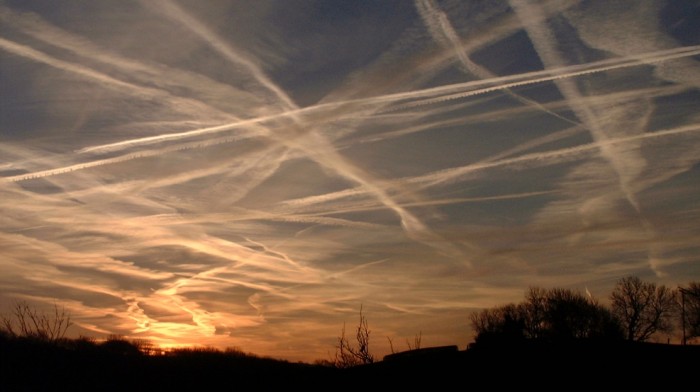Dane Wigington : We are told by “official” sources that the ozone layer is recovering, that we have nothing to worry about. This narrative is being pushed by power structure controlled agencies in order to pacify the public until the last possible moment. How close is that moment? If we remain on the current course, anthropogenic activities (with climate engineering at the top of the list) may completely destroy the ozone layer within the next decade or less. Without the ozone layer, all terrestrial life on Earth (and most aquatic life) will perish.

The “official” sources who tell us climate engineering isn’t happening, who tell us that we are only seeing « condensation trail » grid patterns in our skies, are the same agencies telling us the ozone layer is getting better. Yet, the increasing intensity of UV radiation can be felt on the skin, on surfaces, is scorching foliage and tree trunks, and is sunburning whales and fish.
The increasingly intense UV radiation from the disintegrating ozone layer can and is being metered by experts in the field. In the video above, a former NASA contract engineer discusses the immense and immediate UV radiation dangers we face from the disintegrating ozone layer which he is personally metering with state of the art equipment.
Though the official ozone layer “recovery” lie is still being propagated, some sources are acknowledging reality as the truth becomes ever more difficult to hide.
Much more geoengineering / ozone destruction supporting data is listed below. We must remember and consider that mainstream media sources are not yet willing to admit that illegal climate engineering programs are real, ongoing, and the single largest component of the ozone collapse scenario we collectively face.
Something might be keeping the ozone layer from healing itself.
Certain chemicals chewed a hole in Earth’s ozone layer. But regulating those substances doesn’t seem to have made much difference. ….it’s not showing any signs of recovering…. [source]
Again, this article by the BBC (and many others) make no mention whatsoever of the single greatest ozone destroying factor of all, covert climate engineering / weather warfare global assault.
Science : Geo-engineering scheme damages the ozone layer
An injection of sulfur large enough to compensate for surface warming caused by the doubling of atmospheric CO2 would strongly increase the extent of Arctic ozone depletion during the present century for cold winters and would cause a considerable delay, between 30 and 70 years. [source]
Stratospheric Injections To Counter Global Warming Could Damage Ozone Layer
The new study concluded that, over the next few decades, hypothetical artificial injections of sulfates likely would destroy between about one fourth to three fourths of the ozone layer above the Arctic. [source](hidden)
Increasing UV radiation from ozone layer depletion :
Stratospheric aerosol injection (climate engineering side effects)
[source] Climate engineering and solar radiation management in general are controversial, and pose various problems and risks. However, certain problems are specific to, or more pronounced with this particular technique.[23]
• Ozone depletion: is a potential side effect of sulfur aerosols;[24][25] and these concerns have been supported by modelling.[26] However, this may only occur if high enough quantities of aerosols drift to, or are deposited in, Polar stratospheric clouds before the levels of CFCs and other ozone destroying gases fall naturally to safe levels because stratospheric aerosols, together with the ozone destroying gases, are responsible for ozone depletion.[27]
• Whitening of the sky: Stratospheric aerosols have the potential to whiten the sky and cause more colorful sunsets, dependent on the amount being sprayed.[28] According to a study on cleaner air, resulting solar brightening has been responsible for an increase in corn production over the past 30 years.[29]
• Tropopause warming: and the humidification of the stratosphere.[25]
• Regional warming: Based on the results of the 2014-2015 Geoengineering Model Intercomparison Project, a model with a standard stratospheric aerosol injection scenario, temperatures in the tropics would cool, and higher latitudes warm, ice sheet, and Arctic sea ice decline would still continue, albeit at a reduced rate. Extreme temperature anomalies would also still increase, but to a lesser degree. In regards to these model results, the author of the study Alan Robock noted:
« If geoengineering were halted all at once, there would be rapid temperature and precipitation increases at 5–10 times the rates from gradual global warming. »[30]
• Stratospheric temperature change: Aerosols can also absorb some radiation from the Sun, the Earth and the surrounding atmosphere. This changes the surrounding air temperature and could potentially impact on the stratospheric circulation, which in turn may impact the surface circulation.[31]
• Regional hydrologic responses: Based on the results of the Geoengineering Model Intercomparison Project, there would be a reduction in the global average precipitation around the world, particularly in summer monsoon regions.[30]
If UV radiation had gone “off the charts”, what might it do to aquatic life forms? Let's start with global plankton populations, the foundation for life on earth. Even NASA says high UV radiation would be extremely harmful for these microscopic organisms.
http://www.gma.org/surfing/human/ozonephyto.html (hidden)
http://www.eco-action.org/dt/ozone.html (hidden)
So how are plankton populations doing?
http://www.scientificamerican.com/article.cfm?id=phytoplankton-population
Krill population decline (krill feed on phytoplankton):
http://www.theozonehole.com/consequences.htm
And another review article:
How plankton decline impacts the ocean food chain:
What about our larger ocean life forms, is the increasingly intense UV radiation affecting them ?
Excessive UV damage to marine life:
http://articles.latimes.com/2012/aug/02/science/la-sci-fish-skin-cancer-20120802
Whales getting sunburnt:
http://www.democraticunderground.com/discuss/duboard.php?az=view_all&address=115×265273
http://rspb.royalsocietypublishing.org/content/early/2010/11/08/rspb.2010.1903.full
UV radiation and tree damage:
http://www.for.gov.bc.ca/hfd/pubs/docs/lmh/Lmh49.pdf
Are we seeing problems with trees ?
http://www.eco-action.org/dt/ozone.html (hidden)
http://environment.about.com/od/ozonedepletion/a/whatisozone.htm
What would excessive ozone depletion and increase UV radiation do to us ?
http://www.who.int/uv/health/en/
Is there northern hemisphere ozone depletion that we are not being told about by mainstream media ?
http://news.nationalpost.com/2011/10/02/unprecedented-ozone-hole-opens-over-canadian-arctic/
Global power structures are increasingly desperate to keep populations from panicking as the biosphere collapse accelerates. The recent “ozone layer is recovering” official agency false narrative is a blatant example of the Orwellian world lies and deception we now find ourselves in. We must think for ourselves, we must do objective investigation, we must examine the frontline facts for ourselves, and we must use credible and verifiable data to form our conclusions that we share with others. DW.
https://www.geoengineeringwatch.org/geoengineering-and-the-ozone-layer-recovery-lie/
https://www.geoengineeringwatch.org/geoengineering-is-destroying-the-ozone-layer/
https://www.geoengineeringwatch.org/record-shattering-uv-radiation-levels-finally-confirmed/
https://www.geoengineeringwatch.org/dont-believe-uv-radiation-levels-are-off-the-charts/
https://www.geoengineeringwatch.org/extreme-uv-radiation-is-killing-our-trees/
https://www.geoengineeringwatch.org/geoengineering-and-the-dying-of-the-trees/
May be freely reprinted, so long as the text is unaltered, all hyperlinks are left intact, and credit for the article is prominently given to GeoengineeringWatch.org and the article’s author with a hyperlink back to the original story.


